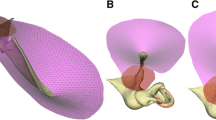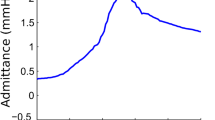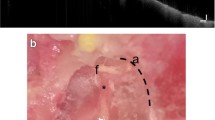Abstract
In hearing science, finite element modelling is used commonly to study the mechanical behaviour of the middle ear. Correct quantitative elasticity parameters are an important input in these models. However, up till now, no large deformation elastic characterization of the pars flaccida, a small part of the tympanic membrane, has been carried out. In this paper, an elastic characterization of the gerbil pars flaccida is presented. The gerbil is used frequently as animal model in middle ear mechanics research. Characterization was done via inverse analysis of in situ static pressure inflation experiments. As a first approach, the pars flaccida was modelled as a linear homogeneous isotropic elastic membrane, which resulted in an average Young’s modulus of \({\left\langle E \right\rangle = (41.0 \pm 0.4)\,{\rm kPa}}\). It was found that linear elastic modelling cannot describe inflation stagnation at high pressures. Therefore, in a second approach, the Veronda–Westmann hyperelastic model was introduced. This was able to describe curve stagnation, the mean parameters that were found are \({\left\langle C_1 \right\rangle = (3.1 \pm 0.4)\,{\rm kPa}}\) and \({\left\langle C_2 \right\rangle = (2.5 \pm 0.2)}\). Finally, in situ strain was considered in the finite element models which resulted in a better description of the behaviour for small pressures. Incorporating this, the optimal Veronda–Westmann parameters are \({\left\langle C_1^{\varepsilon_R}\right\rangle = (2.6 \pm 0.6)\,{\rm kPa}}\), \({\left\langle C_2^{\varepsilon_R}\right\rangle = (1.4 \pm 0.2)}\) for a radial in situ strain of \({\left\langle \varepsilon_R \right\rangle = (12 \pm 2)}\). In conclusion, this paper shows that a linear elastic material is not appropriate to describe pars flaccida’s behaviour in the quasi-static pressure regime, that the currently used membrane stiffness estimates do not hold for large deformations and that incorporating an in situ strain in the models is necessary for a good description for small static pressures.
Similar content being viewed by others
References
Aernouts J, Couckuyt I, Crombecq K, Dirckx JJJ (2010) Elastic characterization of membranes with a complex shape using point indentation measurements and inverse modelling. Int J Eng Sci 48: 599–611
Buytaert J, Dirckx J (2008) Moire profilometry using liquid crystals for projection and demodulation. Opt Express 16: 179–193
Buytaert J, Dirckx J (2010) Phase-shifting moire topography using optical demodulation on liquid crystal matrices. Opt Lasers Eng 48: 172–181
Decraemer W, Funnell W (2008) Anatomical and mechanical properties of the tympanic membrane, chronic otitis media. Pathogenesis-oriented therapeutic management. Kugler Publications, The Hague
Dirckx JJ, Decraemer WF, von Unge M, Larsson C (1997) Measurement and modeling of boundary shape and surface deformation of the mongolian gerbil pars flaccida. Hear Res 111(1-2): 153–164
Dirckx JJ, Decraemer WF, von Unge M, Larsson C (1998) Volume displacement of the gerbil eardrum pars flaccida as a function of middle ear pressure. Hear Res 118(1–2): 35–46
Elkhouri N, Liu H, Funnell W (2006) Low-frequency finite-element modelling of the gerbil middle ear. J Assoc Res Otolaryngol 7: 399–411
Gan R, Sun Q, Feng B, Wood M (2006) Acoustic-structural coupled finite element analysis for sound transmission in human ear—pressure distributions. Med Eng Phys 28: 395–404
Gea SLR, Decraemer WF, Funnell RWJ, Dirckx JJJ, Maier H (2010) Tympanic membrane boundary deformations derived from static displacements observed with computerized tomography in human and gerbil. J Assoc Res Otolaryngol 11(1): 1–17
Gorissen D, Tommasi L, Crombecq K, Dhaene T (2009) Sequential modeling of a low noise amplifier with neural networks and active learning. Neural Comput Appl 18: 485–494
Koike T, Wada H, Kobayashi T (2002) Modeling of the human middle ear using the finite-element method. J Acoust Soc Am 111: 1306–1317
Kroon M, Holzapfel GA (2009) Elastic properties of anisotropic vascular membranes examined by inverse analysis. Comput Methods Appl Mech Eng 198: 3622–3632
Kuypers LC, Dirckx JJJ, Decraemer WF, Timmermans JP (2005) Thickness of the gerbil tympanic membrane measured with confocal microscopy. Hear Res 209(1–2): 42–52
Kyriacou SK, Shah AD, Humphrey JD (1997) Inverse finite element characterization of nonlinear hyperelastic membranes. J Appl Mech 64: 257–262
Ladak HM, Funnell WRJ, Decraemer WF, Dirckx JJJ (2006) A geometrically nonlinear finite-element model of the cat eardrum. J Acoust Soc Am 119(5): 2859–2868
Lim DJ (1968) Tympanic membrane. ii. pars flaccida. Acta Otolaryngol 66(6): 515–532
Roshan JV, Ying H (2008) Orthogonal-maximin matin hypercube designs. Stat Sin 18: 171–186
Rosowski JJ, Ravicz ME, Teoh SW, Flandermeyer D (1999) Measurements of middle-ear function in the mongolian gerbil, a specialized mammalian ear. Audiol Neurootol 4(3–4): 129–136
Sacks J, Welch WJ, Mitchell T, Wynn HP (1989) Design and analysis of computer experiments. Stat Sci 4(4): 409–435
Teoh SW, Flandermeyer DT, Rosowski JJ (1997) Effects of pars flaccida on sound conduction in ears of mongolian gerbil: acoustic and anatomical measurements. Hear Res 106: 39–65
Timoshenko SP, Woinowsky-Krieger S (1940) Theory of plates and shellsw. McGraw-Hill Book Company, Inc., New York
Veronda DR, Westmann RA (1970) Mechanical characterization of skin—finite deformations. J Biomech 3(1): 111–124
Weiss JA, Gardiner JC, Ellis BJ, Lujan TJ, Phatak NS (2005) Three-dimensional finite element modeling of ligaments: technical aspects. Med Eng Phys 27(10): 845–861
Author information
Authors and Affiliations
Corresponding author
Rights and permissions
About this article
Cite this article
Aernouts, J., Dirckx, J.J.J. Elastic characterization of the gerbil pars flaccida from in situ inflation experiments. Biomech Model Mechanobiol 10, 727–741 (2011). https://doi.org/10.1007/s10237-010-0269-8
Received:
Accepted:
Published:
Issue Date:
DOI: https://doi.org/10.1007/s10237-010-0269-8




